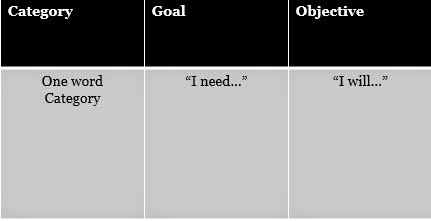 |
| Illinois Firefighter Peer Support |
In
April of this year, I attended training (to become a peer supporter) that was
sponsored by the Illinois Firefighter Peer Support team. One of the assignments required the student
to create a wellness plan, which could be used as a road map to a more balanced
existence with respect to the mind-body-spirit paradigm. The wellness plan asks all of us as
individuals to categorize areas of our lives that we wish to improve on by
setting well defined and measurable goals.
Today’s post will discuss goal setting as well as how to create a
wellness plan template.
SMART
goals
As a personal trainer, it is my job to work
with a client on developing goals that are both specific and realistic in order
to achieve his/her desired results. The
American Council on Exercise (ACE) tells us that in order for goals to be
effective, they need to be SMART:
Specific
·
The goal should state what you
specifically want to accomplish.
Measurable
·
This aspect of goal setting allows you to
see progress.
Attainable
·
Attainment will reinforce commitment to
continue on your road to wellness long after the individual goal has been
reached.
Relevant
·
The goal should be relevant to your
interests and needs.
Time-bound
·
The goal must contain a timeline for
completion. (ACE, 2014).
Before we take a look at the wellness plan
template, let’s examine a common wellness goal that millions of people set as a
New Year’s resolution: weight loss.
Often times a general statement is made such as “I want to lose
weight”. This goal is very broad in nature
and needs to be more descriptive in order to be both effective and
attainable. Using SMART, we will put
this goal into more quantifiable terms:
1.
I want to lose weight (very general).
2.
I want to lose 20 pounds in 2 weeks
(unrealistic).
3.
I want to lose 20 pounds in 4 months
(realistic).
4.
I want to lose 20 pounds in 4 months, and
I will accomplish this by losing 5 pounds per month (measurable and
attainable).
5.
I want to lose 20 pounds in 4 months. I
will accomplish this goal of losing 5
pounds per month by following a combination resistance training (weight
lifting) and cardio program, that has been designed and agreed upon by both
myself and my personal trainer (Specific, measurable, attainable, relevant, and
time-bound).
In order to be successful with your
wellness plan, there must be a high level of individual accountability. Depending on the goal set, or category
chosen, you may have to enlist the services of a qualified professional who can
best aid you in meeting your individual benchmarks.
The
Wellness Plan
The following wellness
plan template comes courtesy of the Peer Support Training Curriculum that was
designed by Sarah Gura, M.A., L.C.P.C. (2014).
 |
| Wellness Plan Template |
The one
word category is defined by
anything you wish to improve upon that will enhance your overall sense of
wellbeing (weight). The goal is written in the form of a need,
as in “I need to lose weight”. The objective is framed by the more specific
statement using the words” I will . . . followed by your plan of action (see
the SMART goals discussed previously).
 |
| Facets of Wellness |
Examples of one word categories with
potential wellness implications include, but are not limited to: food, diet,
smoking, exercise, stress, friends, family, and pain. Before putting the goals and objectives on
paper, always remember to frame them by keeping improvement and personal
accountability in mind. In future posts,
I will provide you with ideas (tools) that you can put in your wellness toolbox,
which can aid in achieving your goals and objectives. Until next time:
Be Well,
Tim
References
Bryant, C., Merrill, S.,
& Green, D. (Eds.). (2014). American
Council on Exercise Personal Trainer Manual (5th ed.). San
Diego: ACE.
Gura, S. (2014). Create a Wellness Plan. Illinois Firefighter Peer Support Training
Curriculum PowerPoint Presentation Day 2, slide 77.
No comments:
Post a Comment